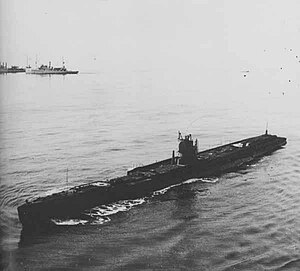SM U-117

SM U-117 at Cape Charles
|
|
| History | |
|---|---|
|
|
|
| Name: | U-117 |
| Builder: | AG Vulcan Stettin |
| Laid down: | 1917 |
| Launched: | 10 December 1917 |
| Commissioned: | 28 March 1918 |
| Homeport: | Kiel |
| Fate: |
|
|
|
|
| Name: | U-117 |
| Acquired: | March 1919 |
| Fate: | Sunk as a target, 22 June 1921 |
| General characteristics | |
| Class and type: | German Type UE II submarine |
| Type: | Coastal minelaying submarine |
| Displacement: |
|
| Length: | 81.52 m (267 ft 5 in) (o/a) |
| Beam: | 7.42 m (24 ft 4 in) |
| Height: | 10.16 m (33 ft 4 in) |
| Draught: | 4.22 m (13 ft 10 in) |
| Installed power: |
|
| Propulsion: | 2 shafts, 2 × 1.61 m (5 ft 3 in) propellers |
| Speed: |
|
| Range: |
|
| Test depth: | 75 m (246 ft) |
| Complement: | 4 officers, 36 enlisted |
| Armament: |
|
| Service record | |
| Commanders: | Kptlt. Otto Dröscher |
| Operations: | 1 war patrol |
| Victories: | |
SM U-117 was a Type UE II long-range minelayer submarine of the Imperial German Navy. She was laid down in 1917, at Hamburg, Germany, by Aktiengesellschaft Vulcan and launched on 10 December 1917. She was commissioned in the Imperial German Navy on 28 March 1918, with Kapitänleutnant Otto Dröscher in command. After shakedown, U-117 was posted to the U-Kreuzer Verband (submarine cruiser unit) on 1 June 1918. Over the next five weeks, she completed fitting out at Kiel.
On 11 July, U-117 departed Kiel and took the eastern route through the Baltic Sea around Denmark and out into the North Sea by way of the Skagerrak. After rounding the Shetland Islands, she set a course for the coast of North America to lay minefields off the coast of the United States and to conduct cruiser warfare. During the voyage across the Atlantic, heavy weather foiled her attempts to attack two lone steamers, two convoys, and a small cruiser.
U-117 reached the American coastal zone on 8 August 1918, and her fortunes improved soon thereafter. On 10 August, she encountered a fleet of fishing craft and went on a spree, sinking nine of the vessels with explosives and gunfire. On 12 August, she sighted the ballast-laden steamer Sommerstadt and, after observing that the Norwegian steamer was armed, made a submerged attack that sank her with a single torpedo. The following day, the U-boat made another submerged torpedo attack and hit the 7,127-long-ton (7,241 t) American tanker Frederick R. Kellogg, bound from Tampico, Mexico, to Boston, Massachusetts, with 7,500 barrels of crude oil. The action occurred only 12 mi (19 km) north of Barnegat Light, New Jersey; however, Frederick R. Kellogg was disabled in such shallow water that the Americans were able to salvage her.
...
Wikipedia
